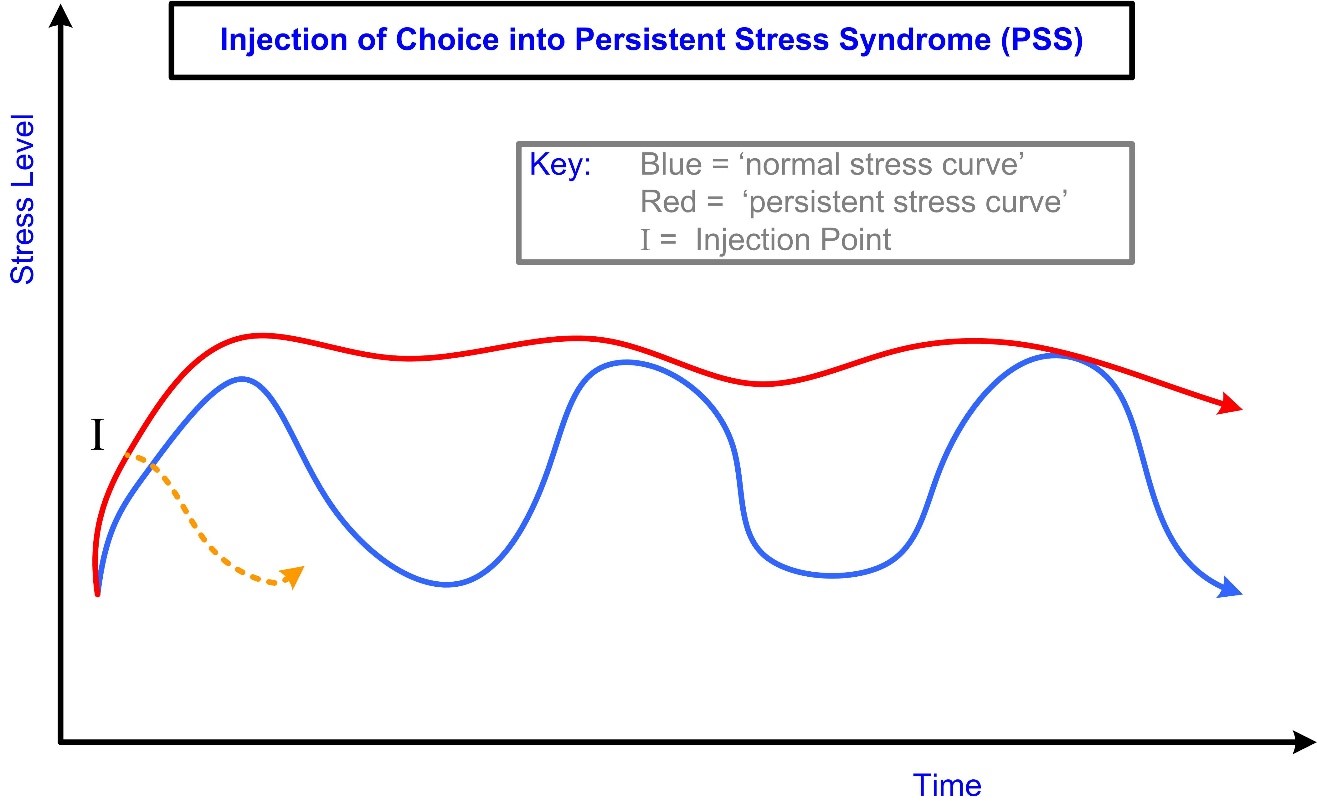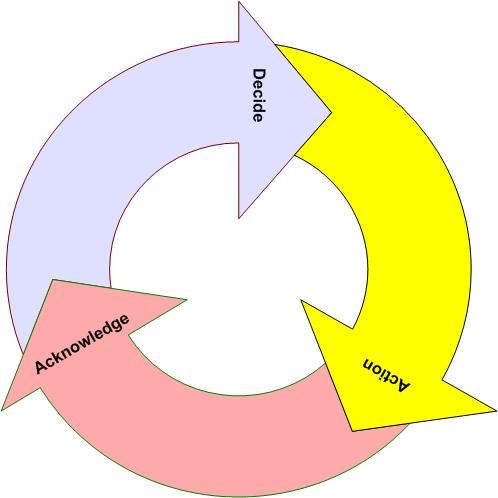WHIN Monthly Bulletin
Fire-fighting is one obvious characteristic of stress. Fire-fighting is only appropriate where immediate decision and action are needed; it reduces self-starting and team-building. Fire-fighting produces a buzz, fuelled by hormones. To counter this process, knowledge and discipline are needed. If not countered, there is a potential to become locked-in to a pattern of stress; the Lock-in Syndrome, which is unhelpful and unproductive for most managing situations and may lead to absenteeism and poor health.
Stress presents in many ways. Although this article focuses on inappropriate fire-fighting, it would be careless of your author to ignore some of the other ways in which stress can be exhibited.
People are different. The fight & flight responses of the mid-brain provide two contrasting reactions in humans with a myriad of characteristics in between! At one extreme is hyper-activity and an inability to slow-down, to sit quietly or to be productively self-reflective. At the other extreme is withdrawal, tension, anxiety, psychological leakage (tics[1]) and illness. A change in behavior may be a sign of stress, particularly if an individual has been called upon to do something different from the norm. Managers must not ignore signs or make judgements. What they need to do is monitor, take time out with the individual and encourage expression. Key factors are the psychological ideals[2] that motivate and de-motivate (calm) effectiveness. These ideals may include, as examples:
Fire-fighting is not wrong per se, if it is consciously chosen as a temporary need, with a specific end. Firefighting from time-to-time is fine provided one can regain one’s composure after that need has passed. The danger comes when the ‘buzz’ associated with one episode is so exciting[3] that the person is unable to calm down again. Instead, they compulsively go to the next fire-fight even if there isn’t one —they may invent a drama in order to create a new fire-fight. An example is the new security guard in a retail store where incidents happen about twice a week, on average. The new guard has just apprehended a customer, called the police and finished the procedure. Within fifteen minutes another ‘situation’ happens on the shop floor due in part to the psychological state of the security guard and her reduced ability to discriminate (while stress hormones are still flooding her blood-stream).
Fire-fights are common in task-oriented businesses running to tight schedules and pressures. Many of us associate fire-fighting with lower and middle management but these days fire-fighting has infected the highest levels in many organizations due to the loss of human resources that used to support senior management. Fire-fighting at senior management level creates incipient weakness in the organization. If most executive work is concerned with putting out fires, tactical decisions may be made, but the strategic development of the business, in the myriad of areas in which this is essential for sustainability, must fall short.
Lock-in Syndrome is a patterned behavior that arises when one starts to go from one fire-fight to the next without a pause. This syndrome is fueled by the biochemical leachate in their blood-stream. Even if that person where able to lie down somewhere quiet, it would take a minimum of twenty minutes to have a significant impact on the concentration of these, as both kidneys and liver need time to removed them from the blood-stream.
Since patterns mostly develop sub-consciously, there are real dangers in being exposed to situations where multiple and sequential fire-fights are the norm. Repeated fire-fights may lead one to Lock-in Syndrome, and without the Syndrome being noticed!
Technically, fire-fighting is the precursor to Lock-in Syndrome (when the individual is no longer able to get back to a relaxed state). Lock-in Syndrome is a patterned response to pressure of work (whether externally real or a self-generated belief). As the demands of work go up, so we stretch the day. We start travelling on Sunday evenings, we work a couple of hours each evening when at home, we arrive an hour before anyone else to clear the desk and then leave two hours later than most people to catch-up on outstanding actions (and the needs of peers and immediate bosses).
Once the pattern has started, the intense focus on work and action means that the ability to focus more widely is lost. You are already locked-in. It takes a major catastrophe to create the trigger for change; to re-value what we do and why we do it. As leaders, it is necessary not to follow the pattern but on entering that pattern, of our own choice and will, to exercise that choice, review as planned and then back out.
If fire-fighting or the Lock-in Syndrome describes the bulk of your work life, what can you do about that?

The figure shows a point ‘I’. This is an Injection Point where the individual may be able to break the pattern before the biochemical flood of adrenaline and neuro-transmitters flood into the blood-stream and linger for twenty minutes or more (one-off) or for hours (chained fire-fights). The key to success is noticing and distracting self with focus on slow-breathing, a calming mantra or memory, as examples. Other solutions are suggested below.
One immediate strategy is to change the beginning of each day. This can start at home or hotel. The earlier in the day you make changes the better. Patterns of thinking and behavior are triggered by a sequence of psychological events that run rapidly and sequentially, usually out of any conscious awareness or control. To challenge the pattern, it is necessary to break it at an early part of the sequence (Injection Point). There are many things which can make a difference including:

It is best to start each day with a period of reflection. Thoughtful, strategic consideration will also get the mind to work in evolutionary processes rather than rapid ‘tda’ decision-mode. With luck, your mind will be more able to return to more strategic work later, after you have dealt with the mail.
Another cycle, designed to prevent fire-fighting is one requiring a short moment to self-acknowledge what you decided to do and your successful meeting of the outcome. It looks like this:

People who fail to self-acknowledge just go from decision to action and to next decision and action without pause. Ultimately, the Lock-in Syndrome can lead to burn-out as seen in some stock-exchanges and banking companies, as common examples.
Where the Lock-in Syndrome has been infecting someone for some time, the chance of them stopping, prioritizing and acting to make a difference is pretty low. Unless, of course, some major personal trauma forces them to revalue. The place to influence them to make changes is outside of work, when they are relaxed. A good mentor can help facilitate their change and whether coached or not, there are some key things likely to need their focus and attention to have success. These things will raise perceptions and appeal to ‘higher values’. Higher values will invariably lead to behavioral change[4]. In this situation, I would be focusing on these:
These statements are designed to gain wider perspective and to create calmer and more effective psychological states. These ‘states’ are important, because the Lock-in Syndrome originates from patterned learning where we have lost personal control over our own reactions to events.
The next level of thinking has to do with strategy. Again, self-reflective thought is required and this in itself perpetuates the experience of relaxed but alert, psychological states. These are things that I would consider:
If you create your own strategy questions, make sure that they satisfy the criteria for self-reflection. The questions attended to at this early stage should not be urgent, as that may encourage stress responses and more fire-fighting.
If you think about your own needs for strategic thinking, how much should you be doing, when should you be doing it and what should you be turning your attention to? A typical answer adopted by the many people that I coach in senior jobs is to allocate two or more hours week. The subjects for strategic thought are updated and planned as part of the process. Here is one such agenda for self-reflection each week:
Many of the people I work with on a 1-2-1 basis leave coaching with calendar entries for the whole year blocked out for ‘Planning’, ‘Strategic Development’ or other appropriate phrase that suits the culture. They have buy-in from their secretaries/peers to book appropriate spaces for this work and to protect those spaces from being regularly captured by others. A strategic approach to work is more efficient and more impressive than running around!
The fire-fighting needs in any organization can lead to poor interpersonal relating and to poor team dynamics and efficiency. These can occur when the same attitudes of urgency persist beyond the immediate needs for decision and action. Where individuals are exposed to repeated fire-fighting needs, they may be at risk to the Lock-in Syndrome. The costs to them in terms of wellbeing, health, working and personal relationships can be dire and difficult to reverse. Managers need to be aware of stress, particularly in environments with repeated episodes of fire-fighting. This awareness should extend to noticing and reflecting on the appropriateness of their own behaviors at work in different contexts. Education about fire-fighting, stress and remedial strategies will reduce the potential for silos of stress. It will also reduce the potential for the development of a widespread stress-culture in a team or organization.
[1]Tics are involuntary and repeated twitches caused my muscle spasms anywhere in the body, but often in the face, hands legs and feet.
[2] These are often referred to as metaprograms; forty of these are peer-review researched and included in the iWAM profiling instrument of jobEQ.com
[3] This buzz is driven by body-chemistry and a number of these chemicals are hormones and neuro-transmitters that swamp into the blood-stream and create physiological affects including erratic breathing patterns, racing heart, tingling fingers, dizziness, abdominal ache, painful kidneys, pallor in the skin, tics, sweating, hand-clenching/gripping and more. These include adrenalin, noradrenalin norepinephrine & cortisol.
[4] The work of Bateson and Dilts informs us of the influencing power of values which are below ‘life-purpose’ in impact according to their independently evolved models.